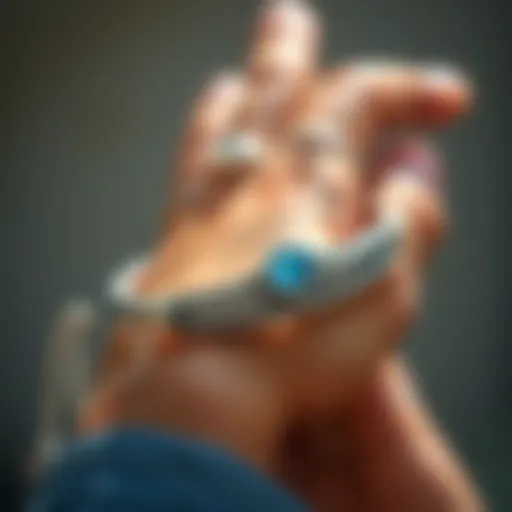Engagement Ring Trends: A Decade-by-Decade Journey
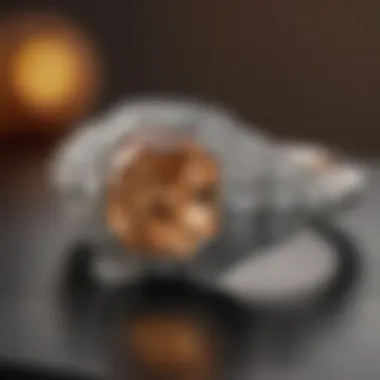
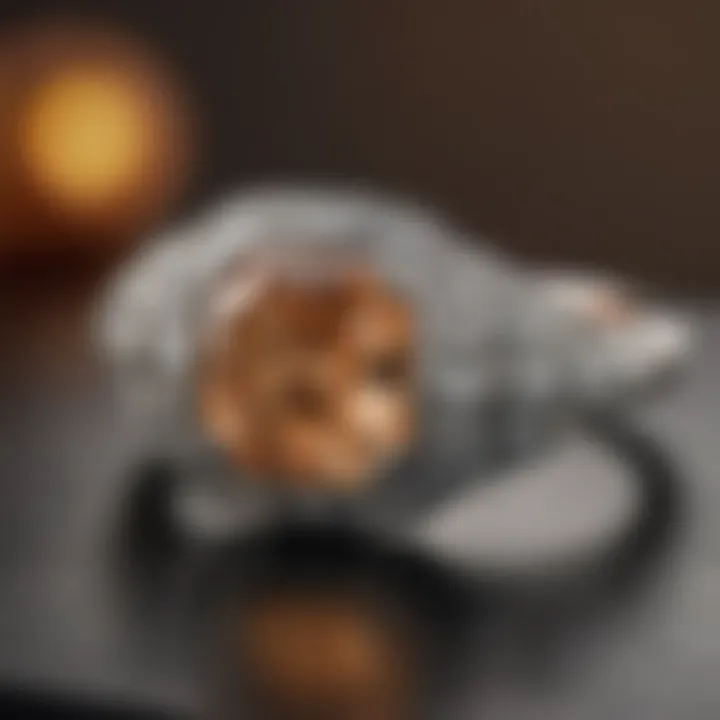
Intro
Engagement rings have long been symbols of commitment, love, and personal connection. Their evolution through the decades not only reflects changes in fashion but also mirrors societal norms and cultural shifts. Every era has its unique preferences—some driven by material scarcity, others by technological advancements—and these factors shape the choices couples make today. In this exploration, we will take a closer look at the role gemstones play in engagement rings, diving into their origins, properties, and the influences that led to enduring styles.
As we travel through time, we will uncover how gemstone selection has been intertwined with societal values, personal expressions, and technological progress. Each piece of jewelry tells a story, not just of the couple, but also of the time in which it was created. From the uncut stones of ancient times to today's ethically sourced gems, the journey of engagement rings is as intricate and layered as the gems themselves.
Gemstone Overview
Definition and Origins
A gemstone, at its core, is a piece of mineral crystal that has been cut and polished to be used in decorative arts or jewelry. The history of gemstones used in engagement rings stretches back to ancient civilizations, where stones were often associated with particular meanings and powers. For instance, the Egyptians believed that specific gemstones could bring protection or good fortune.
In Roman times, the tradition of giving rings began to take a more formal shape, with gemstones frequently embedded into metal settings to showcase wealth and status. Sapphire, ruby, and emerald were among the favored choices, each with its own significance and allure.
Historical Significance
Over centuries, gemstones have been imbued with various cultural significances. In medieval Europe, for example, sapphires were considered symbols of fidelity and love, making them highly desirable for engagement rings. The famous engagement ring of Princess Diana, now worn by Catherine, Duchess of Cambridge, is a blue sapphire surrounded by diamonds—a choice that resonated with tradition while also embodying personal flair.
Understanding these historical contexts informs why certain stones remain popular today. The emotional appeal tied to specific stones enhances their value, not just in monetary terms but also in their symbolic meaning.
Gemstone Properties
Hardness and Durability
One of the key characteristics that influences the choice of gemstones in engagement rings is hardness. The Mohs scale of mineral hardness plays a significant role in determining durability. Diamonds, ranked at the top of this scale, are revered for their unrivaled hardness, making them ideal for everyday wear.
Other stones, such as sapphires and rubies, also offer considerable durability, being nearly as hard as diamonds. On the other hand, softer stones like opals may be subject to scratching and require more careful wear and maintenance.
Color and Clarity
Color and clarity are pivotal in gemstone selection, often dictating both aesthetic appeal and value. The vibrant hues of gemstones can prompt emotional responses, symbolizing different characteristics. For instance, a rich red ruby might evoke passion, while a serene blue sapphire can represent tranquility.
Clarity affects not just how a gemstone looks, but also how it is perceived in terms of quality. Stones with fewer inclusions or blemishes typically command higher prices and are often viewed as more beautiful by collectors and designers alike.
The choice of gemstone not only reflects personal preference but also serves as a bridge connecting current trends to historical significance.
In summary, the evolution of engagement ring trends has intricately linked gemstone selection to social, cultural, and personal narratives. As we move forward, we will delve further into the styles and distinct characteristics that have shaped engagement rings through the decades.
Historical Overview of Engagement Rings
The evolution of engagement rings is more than mere adornment; it's a reflection of societal values, cultural shifts, and personal aspirations. Understanding the historical context surrounding these symbols of commitment unveils the intricate tapestry of human relationships over the centuries. From ancient practices to contemporary designs, each era's engagement ring tells a unique story rooted in its time. This section aims to peel back the layers of history, revealing the influences that shaped the engagement ring into the beloved token it is today.
The Origins of Engagement Rings
Engagement rings trace their origins back to ancient civilizations, where they held deep symbolic meaning. The Egyptians are often credited with being among the first to use rings as a sign of commitment. These early rings, made from braided reeds or leather, symbolized the eternal bond between partners. They believed that the circle represented eternity, a concept that resonates even today. In ancient Rome, rings made of iron were used, often as practical tokens to signify ownership and loyalty.
As cultures evolved, so did the materials and styles of engagement rings. In the Middle Ages, nobles and royalty began to adorn these rings with gemstones, showcasing both wealth and status. Interestingly, it's during this time that the practice of giving an engagement ring became more institutionalized, signaling not just love but also a union of families and assets.
While the concept remained relatively constant for centuries, it was during the 19th century that diamonds started to take center stage. The diamond rush brought forth notions of rarity and durability, connecting these characteristics to the ever-lasting love symbolized by engagement rings.
Cultural Significance in Different Civilizations
Engagement rings have varied meanings across different cultural landscapes. In many Western societies, the diamond engagement ring has become a staple, largely due to successful marketing campaigns such as De Beers'
Influential Trends from the Nineteenth Century
The nineteenth century set the stage for many enduring engagement ring trends. It was a time when personal expression began to intertwine with societal norms, marking a shift from utilitarian objects to more symbolic representations of love and commitment. This era not only influenced design choices but also laid the groundwork for the significance we attribute to engagement rings today. The aesthetic and cultural ideals of this period were reflected in the choices couples made, showcasing their romantic aspirations and social status.
Victorian Era Designs
The Victorian era, spanning from 1837 to 1901 under Queen Victoria’s reign, brought forth some of the most intricate and beautiful designs in engagement rings. Amid this period, artisans began to experiment with various styles and techniques that captured the imagination of the public.
Intricate Metalwork
Intricate metalwork became a hallmark of the Victorian style. Craftsmen of the time poured their heart and soul into creating ornate settings, often incorporating details like filigree and granulation. The key characteristic of this approach lies in its detailed workmanship, which offered a personal touch and elevated an engagement ring from mere jewelry to wearable art.
The unique feature of this metalwork was its ability to tell a story through its craftsmanship, often reflecting the personal style and tastes of the wearer. The advantages included a highly customizable approach that suited many preferences, while a possible downside could be the maintenance required to keep such detailed pieces in their best condition.
Floral Motifs
In addition to intricate designs, floral motifs surfaced as a major trend in the Victorian era. Inspired by nature, these designs captured the delicate beauty of flowers, which often symbolized romance and natural beauty.
This aesthetic choice not only resonated with the lovers of the time but continues to attract the hearts of many today. The incorporation of floral elements brought softness and elegance to engagement rings, appealing to those with a penchant for all things feminine.
The unique feature of floral motifs lays in their ability to be tailored to individual preferences; every bloom could symbolize a personal meaning. On the other hand, the intricacy of these designs may pose challenges in terms of longevity and durability.
Using Birthstones
Another fascinating trend of the era was the use of birthstones in engagement rings. This practice afforded couples a unique way to personalize their jewelry, allowing for the integration of specific gemstones that held personal significance.
The defining aspect of using birthstones is the deep-rooted connection they establish between personal identity and romance. This choice became particularly appealing in the context of engagement, where the desire for a distinctive touch often overshadowed traditional diamond settings.
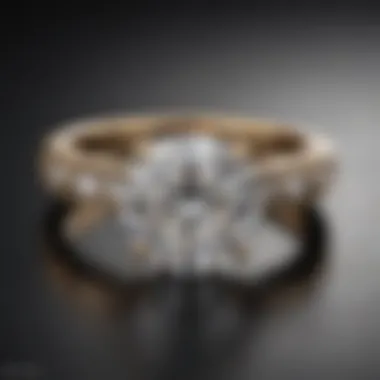
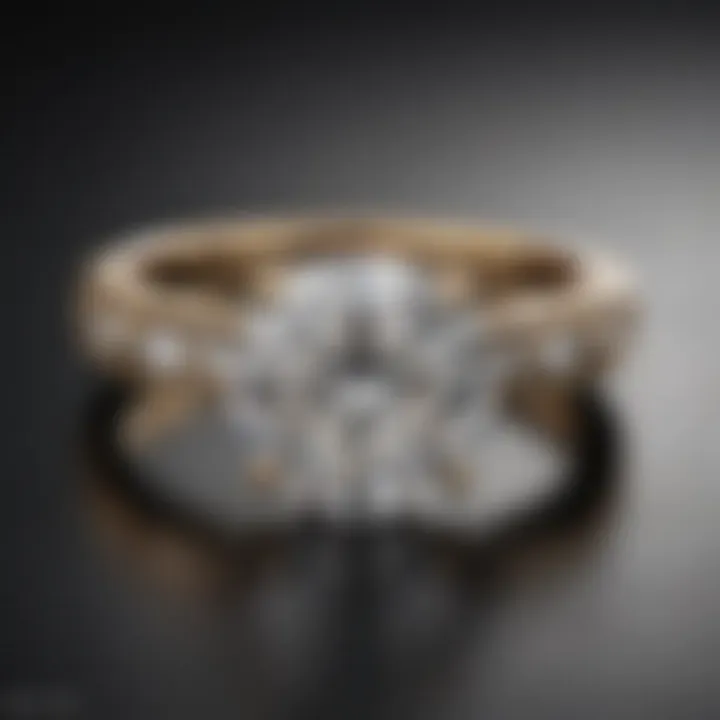
The advantages of birthstones revolve around their individuality and sentimental value. However, one must consider that not every gemstone carries the same robust durability that diamonds do, potentially impacting their longevity as an everyday ring choice.
Emeralds and the Symbolism of Love
As Victorian ideals expanded, so did the preference for alternative stones like emeralds. Beyond beauty, emeralds held symbolic meanings of love and fidelity. Their lush green color and historical associations with prosperity found favor among couples seeking to deviate from the norm of diamond-centric designs.
Incorporating emeralds into engagement rings was sometimes an act of rebellion against societal expectations, asserting one’s individuality while still embracing the significance of commitment. The engagement ring of Elizabeth Taylor, which features a stunning emerald, is a prime example. Emeralds have a rich history laden with emotive characteristics, further enriching the narrative surrounding engagement rings.
"Emeralds are not just a pretty face; they represent love and fidelity through the ages."
Overall, the nineteenth century shaped engagement ring trends that blended artistry with deeper personal significance. Couples were beginning to take a chance on designs that reflected their values, desires, and identities, laying the groundwork for future trends to come.
The Rise of the Diamond Engagement Ring
The diamond engagement ring has come to represent the pinnacle of love and commitment. This trend, which began in the late 19th century and gained immense popularity through the 20th century, has become inseparable from the concept of engagement itself. The allure of diamonds and their perceived value has made them a preferred choice for couples looking to symbolize their everlasting bond. In this section, we’ll explore the influential forces behind this phenomenon, particularly the transformations brought about by marketing strategies, as well as the various diamond cuts that rose to prominence in the early years of the 20th century.
De Beers and the Marketing Revolution
The Concept of 'A Diamond is Forever'
The phrase "A Diamond is Forever" crystallized the marketing genius of De Beers and is perhaps one of the most recognized slogans in history. Launched in the 1940s, this marketing campaign reshaped societal perceptions of diamonds, positioning them as the ultimate symbol of matrimonial commitment. Before this, the custom of giving engagement rings wasn't heavily focused on diamonds specifically. This breakthrough not only elevated the status of diamonds but also tied them closely with the notion of eternal love and loyalty.
The core characteristic of the slogan lies in its emotional appeal, suggesting that the ring represents unending devotion. This encapsulation of meaning is what has made the diamond a beneficial choice for engagements. It is not just about the stone itself; it’s about the message it conveys. Individual couples have integrated this idea, seeking not only to fulfill tradition but to embrace the narrative of everlasting love through the ring.
While the campaign undoubtedly created a standard for engagements, there are opinions surrounding the pressure it puts on couples. The recurring idea of needing a diamond to represent love can feel overwhelming or even financially straining for some. Still, the allure remains strong, leaving couples grappling with the decision, often leaning towards the diamond-centric tradition for validation.
Impact on Public Perception
The widespread adoption of the phrase "A Diamond is Forever" impacted public perception significantly, making diamonds synonymous with love and commitment. Backed by advertising, the diamond ring was transformed from an optional item into a mandatory gesture in engagements. This led to a cultural shift, where diamond engagement rings became a staple of courtship across many societies.
Following the impact of this slogan, the key feature of public perception was that diamonds began to symbolize economic stability and social status. For many couples, showcasing a diamond on their finger became a way to reflect personal success and commitment. The spotlight on diamond quality and size also led to competition among couples, with many feeling pressure to conform to escalating standards regarding what constituted an acceptable engagement ring.
However, this shift also introduced a unique double-edged sword. In one sense, the diamond engagement ring became an enduring symbol of love and commitment, but conversely, it also sparked debates about consumerism and materialism in relationships. While many still embrace the idea, others seek alternatives that resonate with personal values and experiences rather than societal expectations.
Diamond Cuts and Settings in the Early Twentieth Century
Round Brilliant
The Round Brilliant cut emerged as a dominant choice for diamond engagement rings in the early 1900s. Renowned for its exceptional sparkle, the Round Brilliant is designed to maximize light reflection, making it a popular pick for those wanting a ring that shimmers under any lighting. This cut has endured the test of time, remaining a favorite due to its classic and timeless appeal.
The unique feature of the Round Brilliant is its versatility; it can fit beautifully in any setting, from simple solitaires to intricate halo designs. Its widespread popularity has made it a quintessential choice, embodying the idea of elegance and romance. That said, its dominance also means it can feel overly common, lacking the personal touch that some couples might desire.
Emerald Cut Elegance
Emerald cut diamonds, distinguished by their rectangular shape and stepped facets, offer a different aesthetic than the Round Brilliant. This cut is often associated with sophistication and vintage style. The elongated shape enhances clarity and is known for emphasizing the diamond's inner beauty. Many couples appreciate this cut for its understated elegance.
Emerald cuts shine in their unique beauty, often appealing to those seeking a more distinct option that stands apart from traditional engagements. However, the simplicity may not be for everyone, as some find the lack of brilliance compared to the Round Brilliant to be a trade-off. Still, its elegance remains a compelling choice for those keen on a classic yet unique look.
The Asscher Cut's Popularity
The Asscher cut, closely related to the Emerald cut, also gained traction in the early 20th century. With its square shape and deep facets, the Asscher cut is celebrated for showcasing a diamond’s depth while adding a glamorous flair. It quickly became a favored choice among those who admired Art Deco styles.
This cut’s appeal lies in its striking representation of modernity, fused with a vintage feel that resonates with many couples today. It allows for eye-catching designs and pairs well with various settings, thus reflecting personal style while still honoring tradition. However, much like the Emerald cut, the Asscher cut may not glimmer as brightly under certain lighting conditions compared to its Round Brilliant counterpart.
Engagement rings embody stories; their cuts, settings, and the choices behind them narrate personal journeys.
Mid-Twentieth Century Innovations
The mid-twentieth century saw a turning point in engagement ring designs, opening doors to creativity and expression that previous eras hadn’t embraced fully. This period embodied a spirit of change and modernity, influenced by cultural shifts and advancements in technology. The emergence of new styles reflected the desires of couples who craved a ring that was not just a symbol of commitment, but a personal statement as well. The trends from this time continue to resonate, shaping how we view engagement rings today.
Contemporary Styles and Designs
Three-Stone Rings
Three-stone rings are often celebrated for capturing a love story in their design. Each stone typically represents the past, present, and future of a relationship, making it a significant choice for couples. The versatility of three-stone rings speaks volumes; they can be adorned with diamonds or alternative gemstones that share personal meanings. One unique feature of these rings is the potential for customization, allowing couples to select stones that relate specifically to their journey. However, a consideration arises with three-stone designs being more complex and potentially pricier due to additional gemstones and settings. This complexity might deter some, yet for many, it represents a deeper significance.
Vintage Resurgence
Vintage resurgence in engagement rings has proven to be a trend that has roots deeply planted in nostalgia. Inspired by designs from earlier decades, couples find themselves drawn to the intricate detail and craftsmanship that characterized the rings of the past. One of the main characteristics of this trend is the emphasis on uniqueness, with vintage rings often boasting one-of-a-kind features that aren't commonly found in modern designs. This individuality is a major draw, as many people seek to express their distinctive style. However, sourcing genuine vintage pieces can present challenges, such as higher costs or wear and tear that needs careful consideration. Yet, this allure of the past continues to fuel its popularity in the modern jewelry market.
Unique Settings
Unique settings provide a platform for personalization unlike any other, transforming even the simplest stones into standout pieces. From unconventional arrangements to asymmetrical designs, these rings encourage couples to break away from traditional norms. A notable aspect of unique settings is their ability to create a wearable work of art, making each ring not just a symbol of love but an expression of individual creativity. The advantages of these rings lie in their originality, but they can also come with the risk of less structural integrity compared to more classic settings. This might be a concern for some, yet the appeal of personalized artistry often outweighs these potential pitfalls.
Significant Cultural Shifts in Meaning
The Feminist Movement
The feminist movement significantly altered the landscape of engagement ring symbolism during the mid-twentieth century. It brought to light the idea of choice and empowerment in how women approached relationships and commitment. A key characteristic of this shift was addressing the notion that engagement rings should not serve only as gifts from men, but as tokens of mutual love and devotion. As a result, many women began to prioritize the design and meaning behind their rings, seeking styles that resonated with their values. While this empowerment delivers a strong message about equality, it also challenges traditional norms that may still linger in society. Yet, embracing these changes enhances the depth of meaning behind the rings themselves, enriching their significance.
Changing Gender Norms
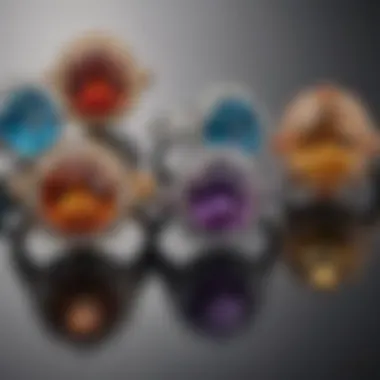
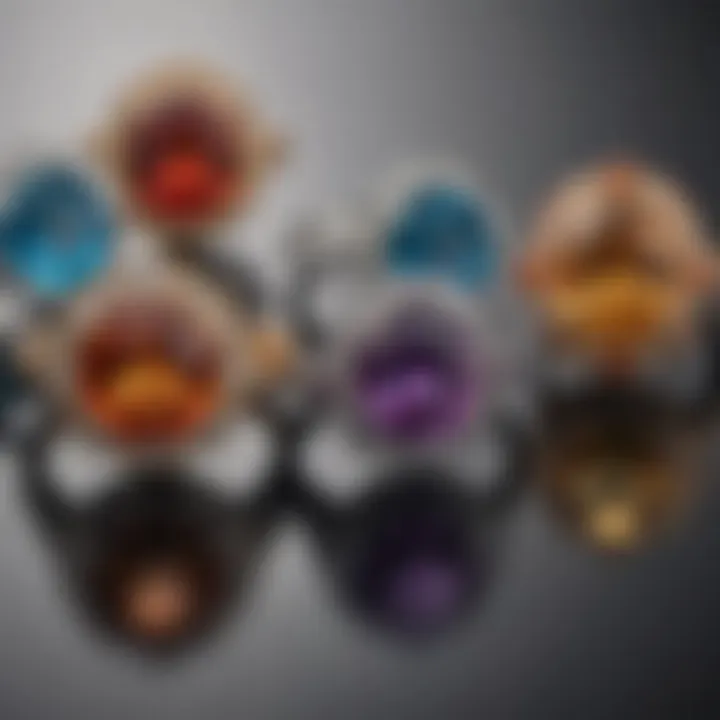
Changing gender norms have also played a crucial role in how we perceive engagement rings today. With an increased focus on equality and shared responsibilities in relationships, the expectations surrounding engagement ring styles are evolving. One key characteristic of this trend is the rising popularity of men wearing engagement rings, which symbolizes the breaking down of conventional expectations. This emerging norm emphasizes that both partners are equally invested in the commitment. However, while many embrace this progress, some might still cling to traditional norms. The beauty of this evolution lies in its ability to highlight diversity and inclusivity in what engagement means, thereby enriching the conversation around this significant piece of jewelry.
Engagement Ring Trends in the Twenty-First Century
In the twenty-first century, the landscape of engagement rings has metamorphosed significantly, reflecting broader changes in values, preferences, and technological advancements. Couples today seek rings that not only symbolize their love but also resonate with their individual identities and ethical considerations. This era emphasizes creativity and diversity, moving away from the once-standard diamond rings. The choices that couples make now often mirror societal shifts toward personal expression and sustainability.
Alternative Gemstones Beyond Diamonds
Sapphires and Other Colored Stones
Sapphires, with their rich hues and durability, have gained traction as a favorite alternative to traditional diamonds. Their versatility allows them to be set in various styles, appealing to those looking to break away from convention. Unlike diamonds, which typically follow a strict grading system, sapphires are often selected based on color intensity and personal preference, allowing for unique representations of individuality.
- Key Characteristic: The striking blue of a sapphire, for instance, presents a luxurious yet distinctive choice. It stands out and often captures the essence of personal stories and relationships.
- Benefits: Aside from aesthetics, sapphires also have a reputation for representing trust and loyalty, making them ideal for engagement rings. Their affordability relative to diamonds means couples can get a larger or higher-quality stone within their budget.
However, while sapphires are resilient, they may not have the same market perception as diamonds when it comes to value retention, which is a consideration for potential buyers.
"Sapphires are not just beautiful; they carry a meaning that often transcends the ring itself."
Ethically Sourced Materials
The emergence of ethically sourced materials marks a crucial development in the jewelry industry. An increasing number of buyers are looking for stones and metals that reflect their values. Ethically sourced gemstones ensure that their origins do not involve environmental harm or human rights violations. This shift is about more than just buying a ring; it's about committing to a decision that aligns with one’s ethical compass.
- Key Characteristic: Materials like lab-grown diamonds or recycled metals offer an eco-friendly alternative, appealing to the environmentally conscious consumer.
- Benefits: Aside from the ethical implications, these materials often come at a lower price point without sacrificing quality. Couples can find beautiful gems that represent their love while still feeling good about their purchase.
On the downside, the market for ethically sourced materials is still developing, and the terminology can sometimes confuse buyers. Not all sellers utilize transparent sourcing practices, making it pivotal for buyers to do their homework before making a purchase.
Customization and Personalization
Bespoke Designs
The growing popularity of bespoke designs speaks volumes about the desire for personal expression in engagement rings. Couples are eager to create rings that tell their unique story or symbolize personal milestones through customized designs. This trend embraces individuality, allowing each ring to be a one-of-a-kind creation.
- Key Characteristic: Bespoke rings can incorporate various elements, from different gemstones to personal engravings. This results in a piece that feels distinctly personal.
- Benefits: Working with a skilled designer gives couples the chance to create a ring that fulfills their vision exactly. It can turn a traditional piece into a tribute to shared experiences or values, making it even more special.
However, the process of designing a bespoke ring can be time-consuming and may come with a higher price tag, which could be a drawback for some.
Artisan Jewelers
Artisan jewelers are at the forefront of this trend, providing skilled craftsmanship that mass-produced jewelry often lacks. They bring a level of artistry that elevates engagement rings to pieces of art. This personalization aspect aligns well with couples’ desires for unique identities in their choices.
- Key Characteristic: Artisan jewelers often tell stories through their work, melding traditional techniques with innovative ideas, producing stunning designs that are often custom-made.
- Benefits: Purchasing from an artisan not only supports local economies but also enhances the connection to the piece. Clients can often engage directly with the jeweler, ensuring every detail meets their expectations.
One drawback could be that with high-demand artisans, there may be waiting times, and sometimes costs may be higher due to the intricate craftsmanship involved.
Collectively, the trends of the twenty-first century depict a more personalized and thought-out approach to engagement rings, moving beyond classic norms and reflecting a deeper meaning behind love and commitment.
Technological Influence on Design and Production
The realm of engagement rings has undergone a transformation, heavily shaped by advancements in technology. This evolution not only redefined design aesthetics but also revolutionized production techniques. The integration of modern technology within the jewelry industry is a game-changer, allowing for greater precision, creativity, and customization. As we delve into this topic, several key aspects come to the forefront.
Advancements in Gemstone Treatments
Heat Treatment
One can't overlook the significant role of heat treatment in gemstone enhancement. Heat treatment primarily aims to improve the color and clarity of gems, making them more visually appealing. The process involves exposing gemstones to high temperatures, which alters their internal structure. This technique can transform a dull-looking sapphire into a vibrant blue that catches the eye instantly. The key characteristic here is its ability to enhance natural beauty while preserving the stone's integrity.
Heat treatment has grown increasingly popular in the engagement ring market. For buyers, the appeal lies not just in aesthetics but also in the practical aspect — treated stones can come at a lower price point compared to their untreated counterparts. This makes beautiful gems accessible to a wider audience without sacrificing quality.
However, potential buyers should be informed about its limitations. While heat treatment can yield fantastic results, it is not always a permanent solution. Some stones might revert to their original state over time, depending on the conditions they encounter. Awareness of these factors is crucial for making an informed purchase.
Irradiation Effects
On the other hand, irradiation effects represent a different dimension of gemstone treatment. This method involves exposing stones to radiation to alter their color in ways that are often striking. A prominent example is the creation of vibrant green diamonds or intense blue sapphires that simply aren't found in nature. The wonderful aspect of irradiation is its ability to produce unique shades that captivate collectors and couples alike.
Irradiated gemstones often become a talking point, adding a layer of intrigue to any engagement ring. The standout characteristic of this treatment is the bold visual impact it offers. Many find themselves drawn to these stones due to their unusual colors and exclusivity.
However, it’s pertinent to discuss the concerns that come with it. While the process is generally deemed safe, buyers should always ask about the treatment and the long-term effects on the stone’s physical properties. This fosters confidence and promotes a genuine relationship between the jeweler and the buyer.
3D Printing and Its Impact on Custom Jewelry
Moving beyond gemstone treatment, 3D printing marks a revolutionary leap in custom jewelry design. It has democratized the way engagement rings can be crafted. With this technology, intricate designs that would have once taken days to create are now available in a matter of hours. The precision of 3D printing allows for customization that caters specifically to individual tastes and preferences.
Several benefits stand out with 3D printing:
- Rapid Prototyping: Designers can quickly generate models, reducing the time from concept to final product.
- Complexity: The technology allows for designs that might be too complicated or cost-prohibitive to achieve by traditional means.
- Accessibility: Even smaller jewelers can invest in this technology, opening the door for unique, bespoke creations that cater to a specific clientele.
However, it's not all roses. As the market expands, so does the risk of lower-quality prints that can affect durability. Consumers should remain vigilant about evaluating craftsmanship to ensure the ring will stand the test of time.
In summary, technological advancements in both gemstone treatment and production techniques are reshaping the engagement ring landscape. These innovations not only enhance beauty but also cater to personal expression, offering a myriad of choices for couples in search of their perfect token of commitment.
The Role of Social Media in Shaping Trends
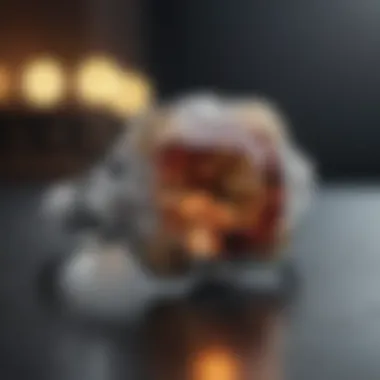

The rise of social media has transformed the way people perceive and choose engagement rings. In an era where visuals speak louder than words, platforms like Instagram and Pinterest have become paramount in influencing modern trends. That's a big change compared to how people shopped years ago, mostly relying on jewelers and personal recommendations. Now, with just a few taps on their phones, couples can gather inspiration, track trends, and share their choices with friends and family. This accessibility to an endless stream of ideas is reshaping what consumers consider desirable in engagement rings.
Influencers and Their Impact
Instagram's Role in Visual Trends
Instagram is a powerhouse when it comes to showcasing engagement rings. Influencers, armed with their eye-catching photos, play a crucial role in making or breaking trends. The key characteristic of Instagram's role in visual trends is its ability to provide a platform for aesthetic presentation. People are drawn not just to rings, but to how they're styled, photographed, and ultimately perceived in daily life.
This makes Instagram a beneficial choice for showcasing engagement rings because it encourages potential buyers to visualize rings outside the traditional retail environment. Its unique feature is the integration of hashtags, which allows users to discover styles, materials, and even artisanal jewelers they might not find otherwise. However, the downside is that the pressure to conform to trends, often driven by influencers, can lead some couples to prioritize trends over personal significance in their choices.
Celebrity Engagements as Benchmarks
Celebrity engagements serve as a shining beacon for many couples. A notable aspect of celebrity engagements as benchmarks lies in their reach; when a well-known figure sports a certain ring, it's likely to send ripples across the jewelry market. The unique selling point here is their ability to elevate specific styles to stardom—like how Meghan Markle’s three-stone ring ignited interest in vintage and bespoke designs.
This appeal stems from not only the glamour associated with celebrity status but also from the aspiration couples feel towards their favorite stars. While this trend can elevate public interest in specific styles, it also brings with it the challenge of oversaturation. When every couple strives for a ring like that of their favorite celebrity, it can homogenize choices, diverting attention from unique, personal expressions.
Community Engagement and Consumer Preferences
Feedback Loops
Social media enables ongoing feedback loops between jewelers and consumers. This characteristic is vital for understanding real-time preferences and potential shifts in the market. Jewelers can directly gauge consumer sentiments based on likes, comments, and shares. This interaction creates an organic dialogue where potential buyers feel their preferences are considered in real-time. The immediate feedback can help adjust product lines before they even hit the shelves.
However, a potential drawback is that the pressure to immediately react can lead jewelers to focus on fleeting trends rather than investing in classic or timeless designs.
Crowdsourced Design Ideas
Crowdsourced design ideas have emerged as an invigorating trend in the jewelry industry. Platforms like Reddit and specialized Facebook groups often see individuals sharing their design concepts, allowing boutique jewelers to tap into a collective creativity. This approach provides a fresh take on traditional designs, combining consumer input with artisan skills. The key characteristic of crowdsourced design ideas is their innovative nature, pushing jewelers to experiment beyond conventional norms.
While this offers several advantages, such as fostering community and generating unique ideas, it also poses a risk. Jewelers might find themselves overwhelmed by diverse suggestions, making it difficult to pinpoint which ideas resonate with the broader market. Over time, this could lead to a dilution of brand identity—something that every jeweler must delicately balance.
Engagement rings are not just about declaring love; they are increasingly becoming extensions of one's personality and social values.
Future Directions in Engagement Ring Trends
As we look to the future of engagement ring trends, it is crucial to examine the evolving preferences of couples today. The choices they make, influenced by environmental awareness, personal expression, and technological advancements, reflect deeper values and considerations. Not only do these trends cater to unique tastes, but they also address pressing concerns like sustainability and social responsibility. Understanding these future directions provides valuable insights for gemstone enthusiasts, jewelers, and couples seeking meaningful representations of their love.
Sustainability Trends in Gemstone Selection
Recycled Metals
Using recycled metals in engagement rings has become increasingly relevant in today’s jewelry landscape. This approach reduces the demand for newly mined materials, thus lessening environmental impact. Recycled metals are generated from previously used jewelry or other metallic sources. One key characteristic of recycled metals is their reduced carbon footprint, which appeals to eco-conscious buyers. By choosing rings crafted from these materials, consumers can contribute to a less destructive mining process and promote responsible consumption.
The unique feature of recycled metals is their ability to retain a sense of history and character. An engagement ring made from recycled materials may carry the story of its previous life, adding a distinctive touch. However, some consumers might have concerns regarding the potential for quality issues associated with recycled metals. It's important to work with reputable jewelers who can guarantee the integrity and craftsmanship of their designs.
Lab-Grown Diamonds
Lab-grown diamonds are rapidly gaining traction as a popular choice for engagement rings. These gems are created in controlled environments through technological processes that replicate natural conditions. The primary advantage of lab-grown diamonds is their environmental sustainability; they require significantly fewer resources compared to traditional diamond mining.
One appeal of lab-grown diamonds is their affordability. Couples can often find larger or higher-quality stones without breaking the bank. Nonetheless, a unique feature of lab-grown diamonds is that they are chemically identical to natural diamonds, offering the same sparkle and allure. The discourse surrounding lab-grown diamonds often involves a debate over their market value compared to natural diamonds, as some may perceive them as less desirable due to their origin.
The Future of Personal Expression in Jewelry
Minimalism
The trend of minimalism in engagement rings reflects a desire for simplicity and elegance. Minimalist designs focus on clean lines and understated beauty, allowing the gemstone to take center stage. This choice caters to individuals who appreciate subtlety over extravagance. Minimalism promotes a move away from overly complex settings, emphasizing quality over quantity.
A significant advantage of minimalist rings is their versatility. A simple design can complement various styles, making it suitable for any occasion. However, its unique feature lies in the challenge of conveying profound meaning through simplicity. Some might find it difficult to express personal sentiment with a minimalistic approach, leading to a preference for more ornate designs.
Symbolic Elements
In modern jewelry design, incorporating symbolic elements has become a way to infuse personal narratives into engagement rings. Many couples are drawn to designs that tell their unique stories, reflecting values or shared experiences. This trend allows for creativity, as rings can involve motifs or engravings that represent milestones or beliefs.
The power of symbolic elements is their potential to elicit emotional connections, making the ring a treasured keepsake rather than just a decoration. However, one consideration is the potential complexity in creating designs that achieve the desired symbolism while maintaining aesthetic appeal. Balancing these aspects is essential to ensure that the ring resonates with personal significance without overwhelming the overall design.
The direction of engagement ring trends indicates a shift toward deeper meanings and ethical choices, highlighting how love stories can manifest in unique and responsible ways.
In summary, as we delve into the future directions of engagement ring trends, it's clear that sustainability and personal expression will play pivotal roles. By exploring recycled metals and lab-grown diamonds, alongside minimalist designs and symbolic elements, couples can navigate their options with a keen eye on both ethical considerations and personal significance.
Finale: The Enduring Significance of Engagement Rings
Engagement rings hold a profound significance that transcends mere adornment. They are symbols of promise and commitment, often representing a couple’s journey and love story. In this article, we've explored how these rings have evolved not just in style, but in their cultural and emotional significance as well. This evolution speaks to the broader changes in society, relationships, and personal values across different eras.
The Balance Between Tradition and Modernity
Navigating the landscape of engagement rings today involves balancing tradition with modern expression. On one hand, many couples hold dear the time-honored practices associated with ring giving. Traditional elements such as the diamond and the specific choice of settings remain popular, steeped in generations of history. For instance, a round brilliant cut diamond still symbolizes classic elegance, deeply rooted in societal expectations and norms.
On the flip side, modern trends invite flexibility. Couples now often prioritize personalization. They might choose non-diamonds or opt for unique gemstone settings that reflect their identities and values. The rise in popularity of lab-grown diamonds and ethically sourced materials is a testament to this shift toward conscious consumerism. Many individuals today find this approach as a means to harmonize their love with sustainability, creating a narrative that resonates with their life philosophy.
This dance between old and new illustrates how engagement rings are increasingly becoming a canvas for self-expression rather than merely a reflection of societal norms.
Final Thoughts on Trends and Personal Significance
As we conclude our journey through the evolution of engagement rings, it becomes clear that each ring tells a story, engraved not just on its surface but also in its choice of gemstone, design, and setting. The trends may change, but the personal significance remains paramount.
Couples today are more aware than ever of what their engagement rings signify beyond the stones they're made of. Whether it's a family heirloom passed down generations or a unique artisan piece that speaks to their shared journey, the personal connection to the ring often outweighs the mainstream trends. This narrative underscores the broader conversation about love, commitment, and identity.
The influence of social media and technology continues to shape preferences, sparking creativity and encouraging couples to express themselves distinctly through their choice of engagement ring. One could argue that today’s rings carry not just the weight of personal significance, but also a blending of art, culture, and societal change.
In summary, engagement rings will continue to symbolize love and partnership, representing a rich tapestry of history and personal expression. For those seeking out the perfect ring, it's essential to remember that the journey is just as valuable as the destination.



